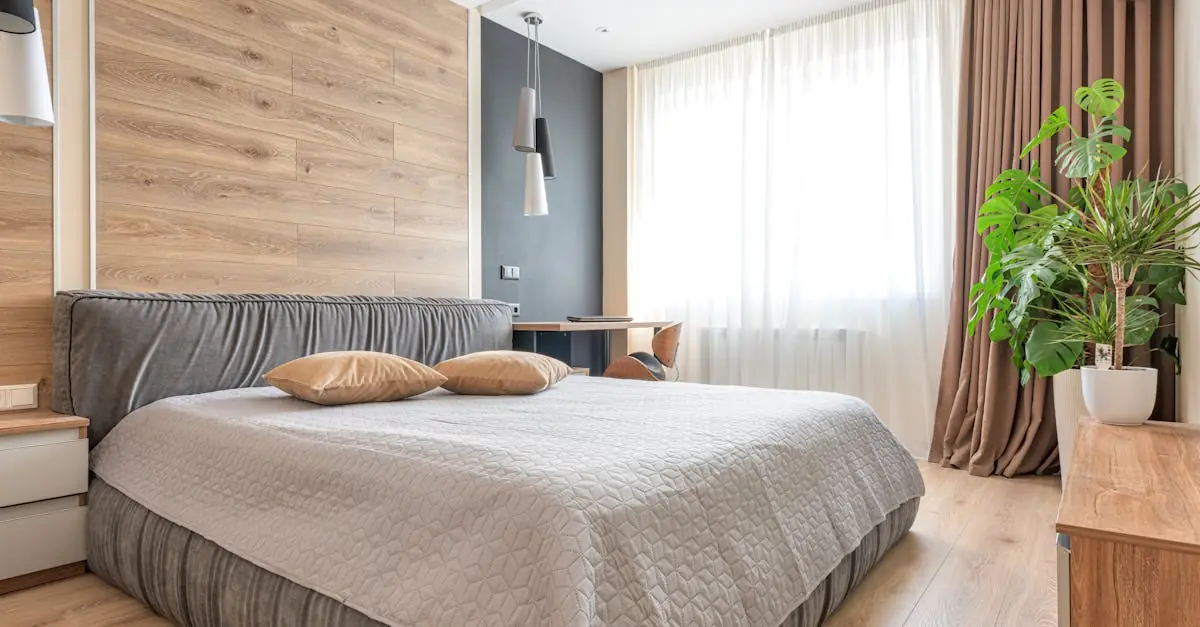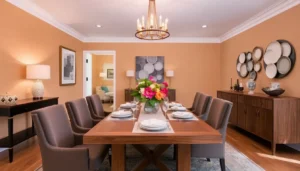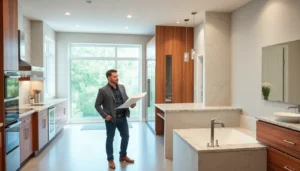Picture this: a living room so effortlessly stylish that even your coffee table gets compliments. Scandinavian interior design brings a breath of fresh air into homes, blending minimalism with cozy vibes. It’s the perfect recipe for a space that feels both inviting and chic, where every piece has a purpose and a story to tell.
With its light color palettes, natural materials, and functional furniture, Scandinavian design transforms ordinary rooms into serene sanctuaries. Who knew that simplicity could look this good? Whether you’re a design novice or a seasoned pro, diving into the world of Scandinavian aesthetics can elevate your living space from “meh” to “wow” faster than you can say “hygge.” Get ready to embrace the beauty of less is more, and let’s explore how to create a living room that’s not just a place to sit, but a stylish retreat.
Table of Contents
ToggleOverview of Scandinavian Interior Design
Scandinavian interior design emphasizes simplicity and functionality. This style prioritizes a clean aesthetic that fosters calmness and order. Light color palettes create a sense of spaciousness, often utilizing whites, soft grays, and muted pastels. Natural materials, such as wood, leather, and stone, enhance the connection to nature and provide warmth.
Furniture in Scandinavian design features sleek lines and often serves dual purposes. Pieces are designed to maximize comfort and practicality, ensuring every element has a purpose. Open spaces encourage a relaxed atmosphere, promoting social interaction and well-being.
Lighting plays a crucial role, especially in regions with limited sunlight. Fixtures are often minimalistic, emphasizing form and function. Large windows invite natural light, while soft artificial lighting creates a cozy ambiance during darker months.
Textures also contribute significantly to this design style. Layering textiles, like wool throws and linen cushions, introduces depth and comfort to the space. Incorporating greenery with indoor plants adds vitality and freshness, enhancing the overall aesthetic.
Artwork and decorative items maintain simplicity. They reflect personal tastes but remain unobtrusive to uphold the tranquil vibe. Each element should contribute to a cohesive and harmonious environment that echoes the Scandinavian ethos of “hygge.”
Overall, Scandinavian interior design prioritizes a blend of beauty and utility, allowing for serene living spaces that are both stylish and functional. With its principles rooted in minimalism and coziness, it inspires individuals to curate spaces that reflect their lifestyle.
Key Characteristics of Scandinavian Living Rooms
Scandinavian living rooms embody simplicity and comfort, showcasing a harmonious balance between aesthetics and utility. They reflect a design philosophy rooted in minimalism and functionality.
Minimalism and Functionality
Minimalism defines the essence of Scandinavian design. Clean lines characterize furniture pieces that prioritize function without sacrificing style. Spaces remain uncluttered, allowing for easy movement and interaction. Dual-purpose furniture, such as storage ottomans or expandable tables, maximizes usability within compact areas. Each item adds value, whether it serves a practical purpose or enhances the overall aesthetic. Even decorative elements reflect this mindset, focusing on essential items that foster tranquility.
Natural Light and Open Spaces
Natural light plays a crucial role in Scandinavian living rooms. Large windows invite sunlight, creating an airy atmosphere that promotes well-being. Bright environments evoke warmth and enhance the perceived spaciousness of the room. Open layouts further contribute to this effect, encouraging social interactions and a sense of community. Light color palettes complement the influx of natural light, amplifying the serene ambiance that Scandinavian design strives for. Spaces blend effortlessly, ensuring the room feels welcoming and lived in.
Color Palette in Scandinavian Design
Color selection in Scandinavian design plays a crucial role in creating serene living spaces. The aesthetic relies heavily on implementing a minimalist yet cozy atmosphere.
Neutral Tones
Neutral tones dominate the Scandinavian color palette. Whites, grays, and soft browns provide a calming backdrop. These shades enhance natural light, making small spaces appear larger. Subtle undertones, such as warm beiges and cool blues, contribute to a tranquil feel. This simplicity creates a cohesive environment, enabling furniture and decor to shine without overwhelming the space. Overall, maintaining a neutral base fosters a sense of serenity and balance in a living room.
Use of Bold Accents
Bold accents introduce vibrant contrasts to neutral backgrounds. Dark blues, deep greens, or even rich reds can serve as focal points. These colors appear through furniture pieces, cushions, or artwork, adding personality without disrupting harmony. Artworks featuring striking designs can become conversation starters while maintaining the overall aesthetic. Introducing natural elements such as houseplants alongside these accents enhances vibrancy. Through a thoughtful application of bold hues, Scandinavian design strikes a balance between simplicity and liveliness in living spaces.
Furniture Selection for a Scandinavian Living Room
Selecting furniture for a Scandinavian living room hinges on embracing simplicity and functionality. Focus on pieces that enhance both comfort and aesthetics.
Iconic Scandinavian Furniture Pieces
Standout items define Scandinavian design. Designers like Hans Wegner and Arne Jacobsen created iconic chairs like the Wishbone and Egg chairs. Clean lines and organic shapes characterize these pieces. Functionality meets beauty in low-profile sofas and wooden coffee tables, often crafted from oak or birch. Natural materials contribute warmth, making spaces inviting. Accent items, such as minimalist shelving units or unique light fixtures, complete the look, fostering a harmonious atmosphere.
Multi-Functionality in Furniture
Multi-functional furniture aligns perfectly with Scandinavian principles. Sofa beds allow for flexibility, accommodating guests without sacrificing space. Nesting tables provide versatility while maintaining an open feel. Storage ottomans offer seating and organization, enhancing practicality. Wall-mounted desks save space, transforming tiny corners into functional work areas. Emphasizing dual-purpose designs supports the essence of Scandinavian living, ensuring each piece serves multiple needs while contributing to a sleek aesthetic.
Decorative Elements in Scandinavian Interiors
Decorative elements enhance the overall aesthetic of Scandinavian living rooms by adding warmth and personality. Textiles and accessories play a vital role in achieving comfort and visual interest.
Textiles and Accessories
Layering various textiles creates depth in Scandinavian spaces. Soft wool throws, knitted cushions, and natural fiber rugs add warmth and texture. Accessories, like simple ceramic vases and minimalist artwork, maintain a clean look while adding character. Choosing neutral colors with occasional bold accents helps balance the aesthetic. Opting for functional decor, such as stylish storage solutions, further enhances the practical nature of Scandinavian design.
Incorporating Nature
Integrating natural elements fosters a serene atmosphere within Scandinavian interiors. Indoor plants, such as succulents or ferns, bring life and a touch of greenery. Wooden decorative items, like bowls or sculptures, introduce organic shapes and textures that resonate with nature. Maximizing natural light through large windows complements these elements while connecting indoor spaces to the outdoors. Choosing materials like stone, wood, or wicker for furnishings reinforces a harmonious relationship with nature, aligning with the Scandinavian design ethos.
Embracing Scandinavian interior design in a living room creates a harmonious blend of style and comfort. By focusing on minimalism and functionality, individuals can transform their spaces into serene retreats. The use of light color palettes and natural materials fosters warmth while promoting a sense of spaciousness.
Incorporating multi-functional furniture and thoughtful decorative elements enhances usability without sacrificing aesthetics. The careful selection of textures and indoor plants adds depth and vitality to the environment. Ultimately, Scandinavian design principles inspire a tranquil atmosphere that reflects personal style and well-being, making it an ideal choice for any modern living space.




